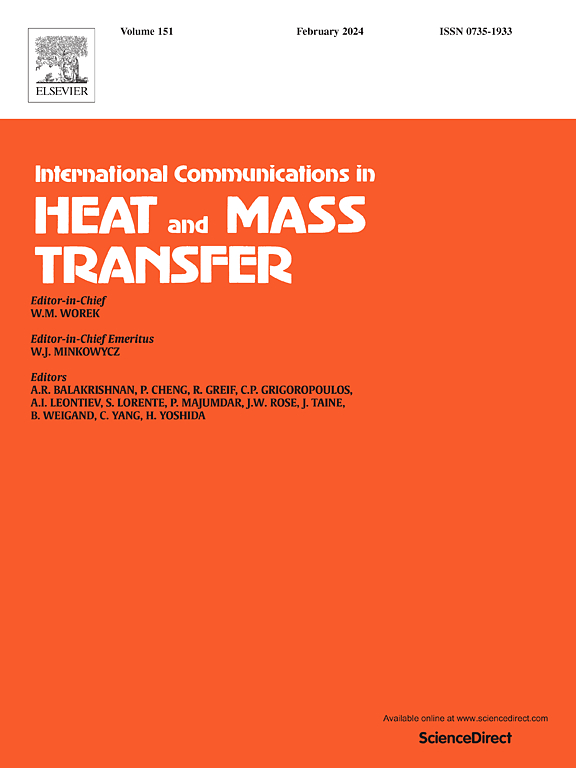Experimental investigation on the influence of copper foam characteristics on pool boiling heat transfer
IF 6.4
2区 工程技术
Q1 MECHANICS
International Communications in Heat and Mass Transfer
Pub Date : 2024-11-13
DOI:10.1016/j.icheatmasstransfer.2024.108318
引用次数: 0
Abstract
Advancements in technology have led to electronics with higher power densities, which strains the sustainability of these devices. In this context, using metal foams in pool boiling can provide solutions by enhancing heat transfer. The porous structure of metal foams affects the boiling parameters such as critical heat flux (CHF) and boiling heat transfer coefficient (BHTC). To study these effects, copper foams of varying thicknesses and PPI were used, and they were attached to smooth silicon surfaces to simulate chip cooling. This research focused on thin foams with 1 mm thickness, which had been sparsely explored in the previous studies. In the ten samples, the CHF increased by up to 85.8 %, and the BHTC increased by up to 141.1 %. Vapor bubble dynamics on copper foam surfaces, which were affected by the foam thickness and PPI, were analyzed. The experimental results show that copper foams significantly enhance pool boiling heat transfer. However, thicker foams increase the frequency of bubble trapping, causing localized overheating which leads to deterioration of heat transfer performance. There was also an optimal PPI value for each foam thickness, which is 40 PPI for the 1 mm thickness and 30 PPI for the 3 mm thickness.
泡沫铜特性对水池沸腾传热影响的实验研究
技术的进步使得电子产品的功率密度越来越高,这对这些设备的可持续性造成了压力。在这种情况下,在水池沸腾中使用金属泡沫可以通过增强传热提供解决方案。金属泡沫的多孔结构会影响沸腾参数,如临界热通量(CHF)和沸腾传热系数(BHTC)。为了研究这些影响,我们使用了不同厚度和 PPI 的铜泡沫,并将它们附着在光滑的硅表面,以模拟芯片冷却。这项研究的重点是厚度为 1 毫米的薄泡沫,而之前的研究对这一厚度的研究较少。在 10 个样品中,CHF 增加了 85.8%,BHTC 增加了 141.1%。实验分析了泡沫铜表面的气泡动力学,气泡动力学受泡沫厚度和 PPI 的影响。实验结果表明,铜泡沫能显著提高池沸腾传热。然而,较厚的泡沫会增加气泡捕获的频率,造成局部过热,从而导致传热性能下降。此外,每种厚度的泡沫都有一个最佳 PPI 值,1 毫米厚度的泡沫为 40 PPI,3 毫米厚度的泡沫为 30 PPI。
本文章由计算机程序翻译,如有差异,请以英文原文为准。
求助全文
约1分钟内获得全文
求助全文
来源期刊
CiteScore
11.00
自引率
10.00%
发文量
648
审稿时长
32 days
期刊介绍:
International Communications in Heat and Mass Transfer serves as a world forum for the rapid dissemination of new ideas, new measurement techniques, preliminary findings of ongoing investigations, discussions, and criticisms in the field of heat and mass transfer. Two types of manuscript will be considered for publication: communications (short reports of new work or discussions of work which has already been published) and summaries (abstracts of reports, theses or manuscripts which are too long for publication in full). Together with its companion publication, International Journal of Heat and Mass Transfer, with which it shares the same Board of Editors, this journal is read by research workers and engineers throughout the world.

 求助内容:
求助内容: 应助结果提醒方式:
应助结果提醒方式:


